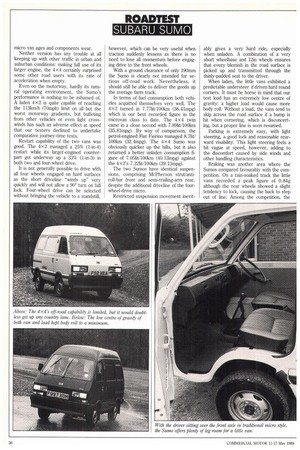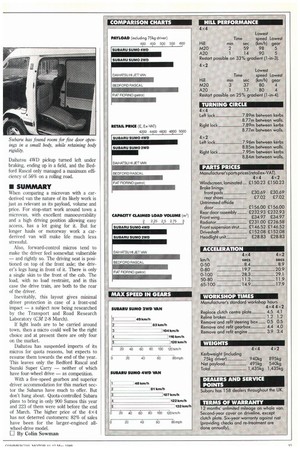ROADTEST SUBARU SUMO
Page 38

Page 39

If you've noticed an error in this article please click here to report it so we can fix it.
micro van ages and components wear.
Neither version has any trouble at all keeping up with other traffic in urban and suburban conditions: making full use of its larger engine, the 4x4 certainly surprised some other road users with its rate of acceleration when empty.
Even on the motorway, hardly its natural operating environment, the Sumo's performance is nothing to be ashamed of. A laden 4 x 2 is quite capable of reaching the 113km/h (70mph) limit on all but the worst motorway gradients, but buffeting from other vehicles or even light crosswinds has such an adverse effect at speed that our testers declined to undertake comparative journey-time tests.
Restart capability of the two vans was good. The 4 x 2 managed a 25% (1-in-4) restart while its larger-engined counterpart got underway up a 33% (1-in-3) in both two and four-wheel drive.
It is not generally possible to drive With all four wheels engaged on hard surfaces as the short driveline "winds up" very quickly and will not allow a 90° turn on full lock. Four-wheel drive can be selected without bringing the vehicle to a standstill, however, which can be very useful when traction suddenly lessens as there is no need to lose all momentum before engaging drive to the front wheels.
With a ground clearance of only 190mm the Sumo is clearly not intended for serious off-road work. Nevertheless, it should still be able to deliver the goods up the average farm track.
In terms of fuel consumption both vehicles acquitted themselves very well. The 4X2 turned in 7.77fit/100km (36.41mpg) which is our best recorded figure in the microvan class to date. The 4x4 twin came in a close second with 7.891it/100km (35.81mpg). By way of comparison, the petrol-engined Fiat Fiorino managed 8.71it/ 100km (32.4mpg). The 4x4 Sumo was obviously quicker up the hills, but it also returned a better unladen consumption figure of 7.05lit/likkm (40.13mpg) against the 4x 2's 7.221k/1001mi (39.13mpg).
The two Sumos have identical suspensions, comprising McPherson strut/antiroll-bar front and semi-trailing-arm rear, despite the additional driveline of the fourwheel-drive micro.
Restricted suspension movement inevit ably gives a very hard ride, especially when unladen. A combination of a very short wheelbase and 12in wheels ensures that every blemish in the road surface is picked up and transmitted through the thinly-padded seat to the driver.
When laden, the little vans exhibited a predictable understeer if driven hard round corners. It must be borne in mind that our test load has an extremely low centre of gravity: a higher load would cause more body roll. Without a load, the vans tend to skip across the road surface if a bump is hit when cornering, which is disconcerting, but a proper line is soon resumed.
Parking is extremely easy, with light steering, a good lock and reasonable rearward visability. This light steering feels a bit vague at speed, however, adding to the discomfort caused by side winds and other handling characteristics.
Braking was another area where the Sumos compared favourably with the competition. On a rain-soaked track the little vans recorded a peak figure of 0.84g although the rear wheels showed a slight tendency to lock, causing the back to step out of line. Among the competition, the Daihatsu 4WD pickup turned left under braking, ending up in a field, and the Bedford Rascal only managed a maximum efficiency of 56% on a rolling road.
When comparing a microvan with a carderived van the nature of its likely work is just as relevant as its payload, volume and price. For stop-start work around town a microvan, with excellent manoeuvrability and a high driving position allowing easy access, has a lot going for it. But for longer hauls or motorway work a carderived van will make fife much less stressful.
Also, forward-control micros tend to make the driver feel somewhat vulnerable and rightly so. The driving seat is positioned on top of the front axle; the driver's legs hang in front of it. There is only a single skin to the front of the cab. The load, with no load restraint, and in this case the drive train, are both to the rear of the driver.
Inevitably, this layout gives minimal driver protection in case of a front-end impact a subject now being researched by the Transport and Road Research Laboratory (CM 2-8 March).
If light loads are to be carried around town, then a micro could well be the right choice and at present there are only four on the market.
Daihatsu has suspended imports of its micros for quota reasons, but expects to resume them towards the end of the year. This leaves only the Bedford Rascal and Suzuki Super Carry neither of which have four-wheel drive as competition.
With a five-speed gearbox and superior driver accommodation for this market sector the Subarus have much to offer. But don't hang about. Quota-controlled Subaru plans to bring in only 900 Sumos this year and 223 of them were sold before the end of March. The higher price of the 4x4 has not deterred customers: 82% of sales have been for the larger-engined allwheel-drive model.
LI By Colin Sowman
























































































































